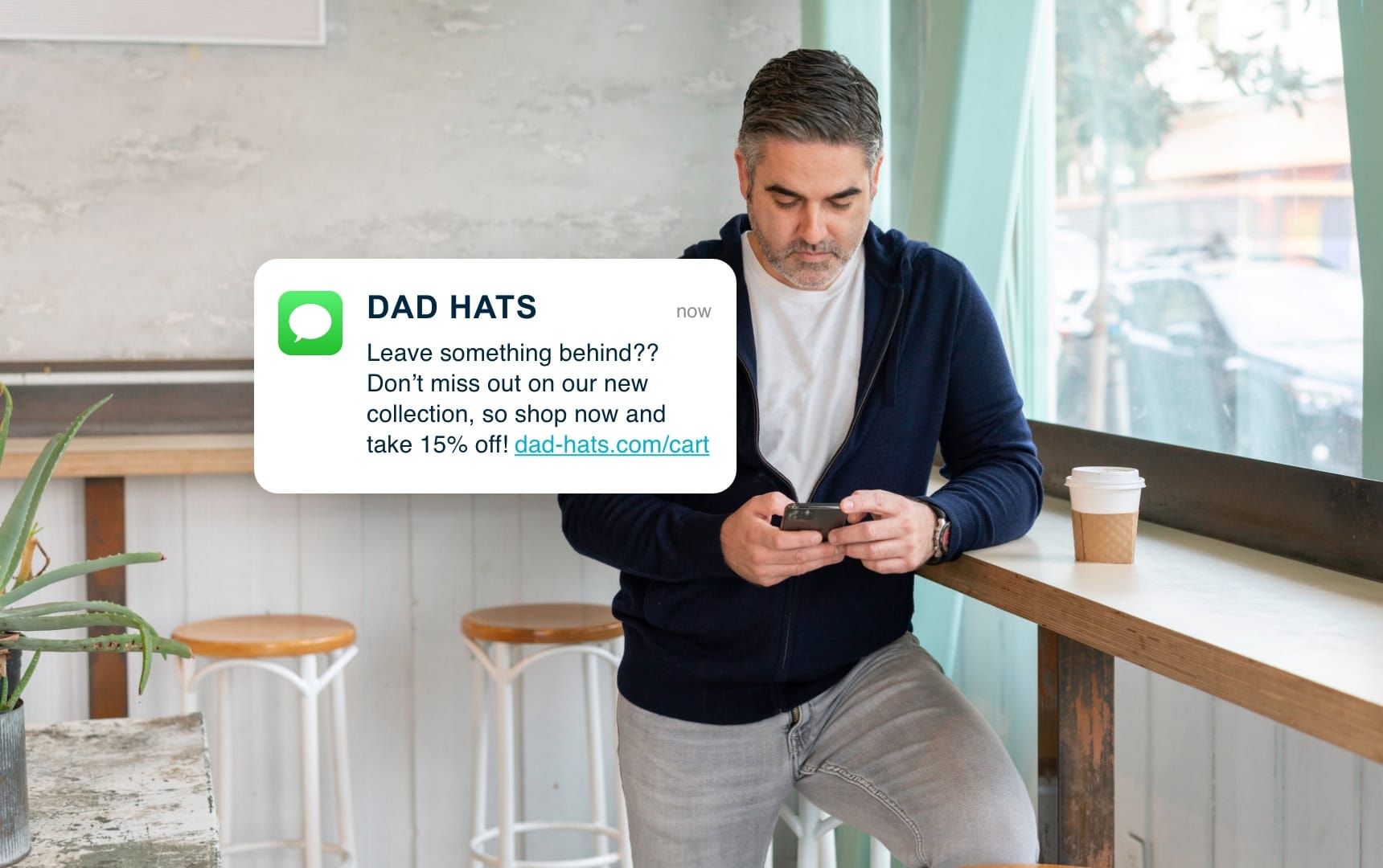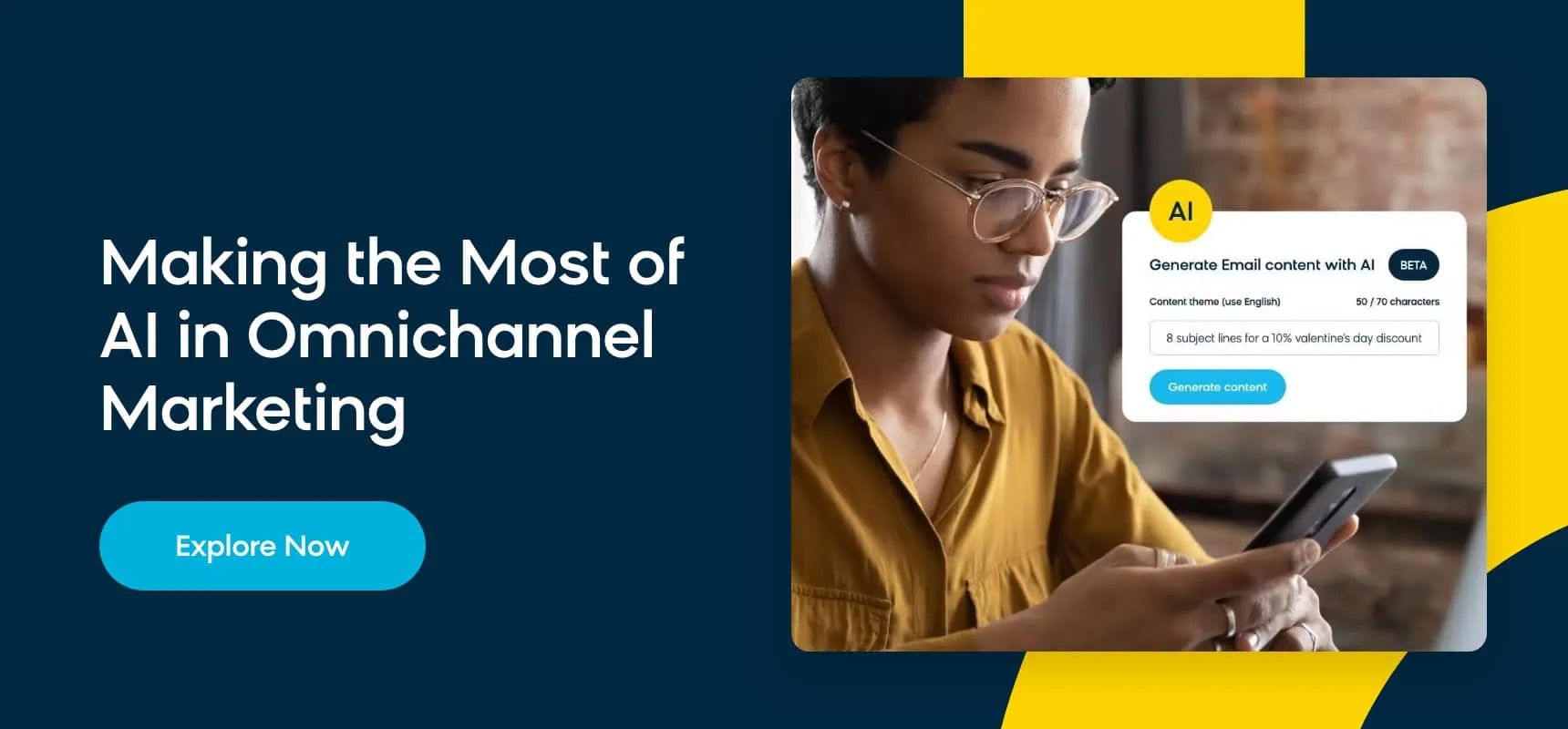If you’re a marketer building out your martech stack in 2025, you’re likely overwhelmed with the sheer amount of specialized solutions available. From email marketing providers to SMS marketing platforms, there are countless tools for you to choose from.
With such a broad range of software out there, marketers face a critical choice when considering what will work best for their efforts. Should you pick and choose individual platforms or should you opt for an all-in-one solution for all your marketing needs?
There are pros and cons to each option. Individual email and SMS marketing platforms claiming to be best-in-breed solutions tend to promise a lot, while comprehensive platforms give you everything you need, right in one place.
But when you lay all the facts on the table, there’s only one obvious answer for modern businesses looking to orchestrate the best campaigns across all the channels their customers use: An all-in-one solution is the best tool at your disposal to create a complete and thorough marketing strategy.
Need convincing? Here are the main reasons why an all-in-one solution is right for your business in 2025.
Why SMS and Email Platforms Cannot Support a True Omnichannel Strategy
SMS and email marketing is often touted as the perfect marketing pair. The two channels complement each other well, and when integrated properly, your SMS and email campaigns can work in tandem to offer the best possible experience for your customer.
Think about your own interactions with marketing — has a brand ever sent you a confirmation email that your shipment has been sent, and then texted you when the package is out for delivery? Or maybe you received a text message about a sale, visited a brand’s site and added items to your cart, and later received an email reminding you to complete your purchase?
These are just a few ways that email and SMS marketing can weave together a seamless omnichannel experience.
With this in mind, it’s reasonable to think that choosing the most specialized email marketing tool along with the most sophisticated SMS platform is the right move for your marketing efforts.
But if your tech stack is made up of separate solutions, you can’t make these two channels truly sync up in the way they’re supposed to.
Your Customer Experience Shouldn’t Be Compartmentalized
The key component of the email and SMS marketing examples we’ve touched on above is the way they work together. Your channels need to collaborate, operating as one to form a customer journey that feels connected and consistent.
But with fragmented platforms, consistency is an uphill battle. Separate vendors naturally treat their channels as distinct entities, and getting them all to work closely with each other isn’t a priority for the businesses that build them.
It will take time and effort to get your email and SMS campaigns working in harmony if you have individual platforms for each channel, simply because each platform is made to put their channel first. That’s the main problem with a patchwork martech stack — your channels are compartmentalized by default, and it’s up to you to link them all together.
Single Vendors Lack Cohesion Across Channels
When you have multiple vendors, integrating and syncing channels isn’t easy. And the consequences of this can have a major impact on the effectiveness of your overall marketing strategy.
When all your channels aren’t unified, you’ll inevitably see cracks at the foundational level of your campaigns. It can be challenging to simply know how many communications each customer has received and whether they’ve already taken the action you want.
If you’re promoting a sale with an email marketing campaign and your customer clicks through and makes a purchase, the rest of your channels need to know. Your SMS campaigns need to be plugged into your purchase data and click-through data across all your campaigns, so you can drive customers to the next phase of the customer experience instead of bombarding them with out-of-step messages on multiple marketing channels.
This might sound basic, but so many brands fall short of this simple fact of journey orchestration. And it’s especially difficult to do if you’re not managing your campaigns from one central platform.
If you have multiple solutions that can’t recognize your other marketing efforts’ success at different steps in the customer journey, you can’t hope to build a marketing strategy that has all your channels working toward a shared objective.
How All-in-One Solutions Keep Your Marketing in Sync
All your communications should be intentional and take into account your customer’s recent behavior (or lack thereof). That’s the cornerstone of omnichannel marketing, which every business should strive for.
It’s the only way to ensure you send truly personalized communications to the right person at the right time, reaching every individual customer on the most appropriate channel with a message that genuinely resonates. And in a world where marketers are constantly asked to do more with less, you can’t afford not to craft the best omnichannel strategy possible for your business.
That’s why an all-in-one solution is so vital. With your channels woven together in a single platform, you can tailor all your campaigns across all channels to pivot when needed. Comprehensive solutions do this intuitively, with no barriers between your SMS marketing messages and your email campaigns.
A single, central platform doesn’t pit your channels against each other. It doesn’t want you to send more messages through a specific channel. It’s designed to make your overall strategy as comprehensive and consistent as possible, putting your customer’s experience above all else.
And that’s exactly what modern businesses need to get ahead.
Why Attribution Issues Are Inevitable for Individual SMS and Email Marketing Platforms
Reporting on and analyzing your campaigns are just as important as building them, if not more so — especially when it comes to how much revenue-driving credit you can give to your marketing campaigns.
Marketers need to see if their text messages are positively influencing their overall earnings or if their email messages are making an impact on their business’ bottom line. But you can’t clearly see how much revenue is attributed to one channel or the other if you have various single-vendor solutions.
Email and SMS Platforms Want to Look Like Your #1 Channel
Again, it’s important to state that each single-platform vendor is a business. And as a business that wants your company to continue using their platform, they inevitably want to take credit for as much revenue as possible. It’s in a single-platform vendor’s best interest to aggressively overreport on attribution.
When you look at attribution reports for your email marketing campaigns, your email provider will prioritize telling a more favorable story for their platform. The same goes for your SMS marketing campaigns. And these two attribution models will likely conflict, leaving marketers with a skewed view of their marketing strategies.
With different platforms telling you different stories, there’s no real way to know if a channel is performing as well as you think it is. You might end up overcompensating and pouring more budget and resources into a channel that you think is performing the best, but this ultimately benefits your vendor — not necessarily your bottom line or your customer’s experience with your brand.
When Platforms Grade Their Own Homework, Marketers Suffer
Marketers want the ability to see the clearest and fairest picture of attribution as possible, which shouldn’t be a difficult task for your martech solutions. But it’s not a given when you opt for a tech stack filled with single-service platforms.
Your SMS marketing platform will assign attribution differently than your email marketing provider, and your overall strategy will pay the price for gaps between your insights.
To make sure you don’t get led astray by biased attribution, you need a platform that will show you the performance of all your marketing channels fairly and allow you to customize your reporting in a way that makes sense for your business.
You want a vendor that’s not going to skew your reporting, favor one communication channel over another, or diminish the results of your marketing strategy.
How All-in-One Solutions Offer Data You Can Trust
The easiest way to avoid any attribution problems is with a comprehensive marketing platform.
It’s not in an all-in-one solution’s best interest to display a bias for any particular channel — it doesn’t need your SMS messages to perform better than your marketing emails. An all-in-one platform is built to keep all your channels working cohesively together, with a focus on optimizing your overall strategy for the best customer experience possible.
When you request attribution analysis from a single, powerful platform, you just get the true output of your efforts, which is what marketers need to optimize and refine their campaigns.
How the Costs of Single Vendors Add Up
Initially choosing your platforms and patching together a single-vendor martech stack is a real challenge, but the headaches don’t stop there.
It’s no easy task to learn how to use a bunch of single-solution tools, continually manage them all, and constantly juggle the expenses of a crowded software toolbox.
When you have more platforms, you typically have more costs and expenses. There’s no getting around the fact that multiple solutions come with multiple price tags, while an all-in-one platform offers a more efficient (and often more affordable) payment structure.
But money isn’t the only thing you have to gain with an uncomplicated martech stack. When you go with an all-in-one platform, you’re consolidating the tools you have to manage, the time it takes for your team to learn how to use them, and ultimately, the marketing budget you have to work with.
You could pay to create and send SMS messages through one platform while also paying to craft messages for your email subscribers in another, all while training your team to use both. Or, you can pay a consolidated price for a comprehensive solution, have your team learn one platform, and orchestrate all your campaigns in one place.
The answer is clear: It’s in every business’ best interest to consolidate. It allows your team to be much more efficient and frees up more time and resources to allocate towards creating the most effective strategies, which benefits both your business and your customers.
Why All-in-One Platforms Give You All Your Data, All in One Place
When you string together multiple platforms — one for email marketing, another for SMS marketing, more for other channels — you’re inherently missing an important, bird’s-eye view of your customers. You need a unified source of truth, where all your customer data converges in a centralized hub.
Essential Segmentation and Automation Features for 2025
Modern email and SMS marketing platforms must deliver sophisticated automation capabilities that go beyond basic scheduling. Enterprise brands require advanced features that can respond to customer behavior in real-time and orchestrate complex, multi-channel campaigns.
Behavioral Triggers That Drive Results
Effective behavioral triggers automatically respond to customer actions across your entire digital ecosystem. Cart abandonment sequences seamlessly transition from email reminders to SMS urgency messages, while browse behavior tracking enables personalized product recommendations across channels. Purchase anniversary campaigns combine email celebrations with SMS exclusive offers, creating memorable experiences that drive repeat purchases and strengthen customer loyalty.
Advanced A/B Testing Tools
Comprehensive A/B testing capabilities allow marketers to optimize both email and SMS campaigns simultaneously. Test subject lines against SMS preview text, compare email call-to-action buttons with SMS link placement, and analyze cross-channel timing strategies. Advanced testing includes multivariate experiments that examine how email design changes impact SMS engagement and vice versa.
Customer Journey Mapping and Orchestration
True customer journey mapping requires cross-channel orchestration that single-vendor solutions simply cannot provide. Map complete customer lifecycles from initial email acquisition through SMS retention campaigns, identifying optimal touchpoints for each channel. Visualize how customers move between email and SMS interactions, enabling marketers to create more cohesive, personalized experiences that guide customers toward conversion.
Industry Success Stories and Performance Benchmarks
Different industries achieve remarkable results when they move from fragmented tools to unified platforms. Understanding these real-world outcomes demonstrates the tangible value of comprehensive solutions.
Retail and Ecommerce Performance Gains
Retail brands using integrated platforms see dramatic improvements in customer lifetime value and conversion rates. Seasonal campaigns coordinate email lookbooks with SMS flash sales, while inventory alerts ensure customers never miss restocked items. Bloomreach clients typically experience 30-40% increases in revenue per recipient when moving from siloed tools to unified platforms.
Fashion and Lifestyle Brand Results
Fashion brands benefit enormously from coordinated seasonal campaigns that leverage both email and SMS strengths. Email showcases new collections through rich visuals and storytelling, while SMS drives urgency for limited-time offers and exclusive access. Cross-channel styling tips and trend alerts create engaging experiences that position brands as lifestyle authorities rather than just retailers.
CPG and Consumer Brand Outcomes
Consumer packaged goods companies excel with loyalty and retention features that span multiple channels. Email newsletters share recipes and usage tips while SMS delivers personalized replenishment reminders and exclusive discounts. Integrated platforms enable sophisticated segmentation based on purchase frequency, product preferences, and engagement patterns across all touchpoints.
Platform Performance and ROI Metrics
When evaluating marketing platforms, performance metrics and return on investment become critical decision factors. All-in-one solutions consistently outperform siloed approaches across key business metrics.
Unified platforms typically deliver 25-35% higher email open rates and 40-50% improved SMS engagement compared to separate vendor approaches. This improvement stems from better audience segmentation, coordinated messaging, and reduced customer fatigue from competing communications.
Customers report average implementation timelines reduced by 60-70% when choosing comprehensive solutions over multiple vendors. Total cost of ownership decreases by an average of 30-40% when factoring in integration costs, training time, and management overhead of multiple platform relationships.
Essential Platform Integrations for Enterprise Marketing
Seamless integrations form the backbone of any effective marketing technology stack. All-in-one platforms excel by offering native connections to essential business systems without the complexity of managing multiple vendor relationships.
Ecommerce Platform Integrations
Shopify, WooCommerce, and Magento integrations enable real-time data synchronization for product catalogs, customer behavior, and purchase history. These deep integrations power sophisticated automation workflows that respond instantly to customer actions, creating seamless experiences from browsing to post-purchase engagement.
CRM and Customer Data Integrations
Salesforce, HubSpot, and other CRM integrations ensure customer data remains synchronized across all touchpoints. Marketing teams can leverage sales interactions to inform email segmentation while sales teams access email engagement data to prioritize leads and personalize outreach efforts.
Analytics and Business Intelligence
Integrations with Google Analytics, Adobe Analytics, and business intelligence platforms create comprehensive reporting environments. Marketers can analyze email and SMS performance alongside website metrics, conversion data, and customer lifetime value calculations in unified dashboards.
Compliance and Data Protection Standards
Enterprise marketing requires robust compliance capabilities that protect both businesses and customers. Comprehensive platforms build compliance features directly into their core functionality rather than treating them as afterthoughts.
GDPR compliance ensures European customer data receives proper protection through built-in consent management, data portability features, and automated deletion capabilities. Integrated platforms make compliance easier by centralizing all customer data and communication preferences in a single system.
TCPA compliance for SMS marketing includes automatic opt-out processing, consent documentation, and sending time restrictions. All-in-one solutions automatically apply these protections across all campaigns, reducing legal risk and ensuring consistent compliance practices.
SOC 2 Type II certification and enterprise-grade security standards protect sensitive customer data through encryption, access controls, and regular security audits. Comprehensive platforms invest heavily in security infrastructure that would be cost-prohibitive for smaller, specialized vendors.
How Comprehensive Platforms Put the Customer First
It’s kind of like grocery shopping. You could go to seven different places to get the right ingredients you want or the best prices.
You could go to a butcher to make sure you get the best meat, drive across town to the farmers market to get your produce, stop at a discount store to get a few select items for cheaper, and so on. There are benefits to going to each individual place for each individual item on your list.
But overall, does it make your grocery shopping experience better? Is the time, cost, and hassle worth it?
Going to a grocery store that satisfies the overwhelming majority of your needs, so you can optimize your time and costs, is a much better option — that’s why there are great grocery stores that offer this kind of comprehensive service. And the same is true for marketing solutions.
A Great Strategy Is More Important Than the Perfect Channel
Striving for perfection in each of your channels takes away from the big picture of your marketing efforts.
Yes, single vendors let you optimize your email marketing or your SMS marketing to a meticulous degree. But what are the consequences of hyper-focusing on these channels? Your painstaking calibrations come at the expense of other marketing initiatives. Ultimately, these can chip away at the effectiveness of your overall strategy.
The truth is, there’s no such thing as the perfect marketing channel. That’s the old way of strategizing, with too much emphasis on individual channel performance. If you’re constantly over-optimizing, there are inevitably trade-offs to make that possible.
You might have the world’s perfect email flow that you’ve built in the world’s most granular email marketing platform, but you’re undoubtedly spending a lot of time and energy on building and maintaining that channel at the expense of other important parts of your customer experience.
Instead of a channel-centric approach, modern businesses need a customer-centric approach to marketing in order to connect with today’s consumer. Getting your channels to work together is the most important goal for your customer experience. You need to set your sights on making the best overall strategy possible.
This is especially true with the rapid rise of AI-powered marketing technology, which allows businesses to take this customer-centric approach and personalize every campaign to an audience’s individual preferences.
Artificial intelligence can leverage your customer data and identify when a specific customer is more partial to email marketing campaigns or more prone to opening SMS messages. It can know if a morning SMS message is more effective for a unique audience member or if an email at lunch time would perform better. It can help you automatically send the right campaigns on the right channels at the right time, without having to hyper-fixate on a single channel or painstakingly build over-optimized workflows with tons of rules and conditions.
Read This Next: Make the Most of AI in Omnichannel Marketing
But this level of personalization is only possible with a customer-centric approach to marketing. You need your marketing channels to be fully integrated and your customer data fully accessible to harness the incredible features that AI can offer.
That’s why an all-in-one solution is so important. A comprehensive platform is geared toward bringing all your data together and making your overall customer experience the best it can be. It connects all your channels seamlessly and keeps your marketing ahead of the curve, which single solutions can’t hope to achieve.
Bloomreach Is the All-in-One Solution You’re Looking For
For a comprehensive solution that meets all your marketing needs, look no further than Bloomreach Engagement.
Our all-in-one platform is an omnichannel marketing solution that brings customer data, automation, AI, and analytics together so marketers can build personalized campaigns from one place, for millions of customers.
Instead of working with siloed point solutions, you can deliver connected customer experiences with a single platform. Bloomreach Engagement creates a single customer view for marketers that helps facilitate the creation of personalized product recommendations, personalized email and SMS campaigns, and so much more.
Interested in learning more? Check out our case study on the omnichannel success that Notino achieved by building interconnected customer experiences with Bloomreach.
Frequently Asked Questions
What makes an all-in-one platform better than separate email and SMS tools?
All-in-one platforms eliminate data silos and attribution conflicts while reducing costs and complexity. Unified customer data enables smarter segmentation, better personalization, and coordinated cross-channel campaigns that separate tools simply cannot achieve.
How does Bloomreach compare to other email and SMS marketing platforms?
Bloomreach differentiates through advanced AI personalization, enterprise-grade scalability, and comprehensive customer data unification. Our platform processes billions of customer interactions to deliver individualized experiences that drive measurable revenue growth for major brands.
What integration options are available?
Bloomreach offers 500+ native integrations including Shopify, Salesforce, Magento, and major analytics platforms. Our flexible API architecture enables custom integrations while pre-built connectors ensure rapid implementation for common business systems.
How quickly can we implement email and SMS campaigns?
Most brands launch their first campaigns within 2-4 weeks of implementation. Our plug-and-play templates, dedicated onboarding team, and comprehensive training resources accelerate time-to-value while ensuring best practices from day one.
How does unified attribution reporting work?
Bloomreach provides unbiased, cross-channel attribution that shows true campaign performance without vendor bias. Our advanced modeling accounts for customer journey complexity, giving marketers accurate insights for budget allocation and strategy optimization.

















